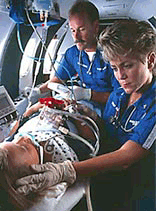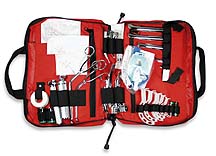THE AIRWAY IN AEROMEDICAL EVACUATION
D. John Doyle MD PhD
October 2016
THE CASE OF THE
MAN WITH NASTY
CELLULITIS
A 73 year old man suspected to be in early septic shock (that is, believed to be developing sepsis syndrome) is to be transported to Miami from southern Mexico via a Lear Jet equipped with a special patient stretcher and seating for pilot / copilot / MD / RN / paramedic and one relative (luggage space permitting).
The medical history for the patient started with a cut foot on the beach on a winter holiday, which somehow deteriorated into a nasty cellulitis involving most of the right leg. There has been a fever and leukocytosis of 36 hours duration. No oxygen is in use. An IV running TKVO is in place. Monitors include EKG and pulse oximetry, with intermittent BP, respiratory rate and temperature measurements. Temp 38.3 BP 100/70 HR 115 Pulse oximeter reads 91% Respiratory rate 25 WBC 25.
Past medical history includes an appendectomy 10 years ago and an uncomplicated non Q wave MI last year at age 72, but is otherwise unremarkable in most other respects.
No allergies.
Meds: IV cloxacillin.
What are the airway considerations in aeromedical evacuation of patients such as this individual?
What if this patient had proved difficult to intubate in the anesthetic for his appendectomy?
DISCUSSION
What are the airway considerations in aeromedical evacuation of patients such as this individual?
The main airway-related considerations in aeromedical evacuation are as follows
• Relatively few physicians other than anesthesiologists have extensive clinical experience in difficult airway management
Relatively few physicians other than anesthesiologists have extensive clinical experience in difficult airway management
• Fewer still physicians are experienced in advanced airway techniques
Fewer still physicians are experienced in advanced airway techniques
• Confined space / difficult access to patient’s head makes intubation and CVP line insertion difficult even for experienced experts.
Confined space / difficult access to patient’s head makes intubation and CVP line insertion difficult even for experienced experts.
• Airway equipment selection available is limited.
Airway equipment selection available is limited.
• Portable, battery-operated suction must be available to clear the airway of secretions.
Portable, battery-operated suction must be available to clear the airway of secretions.
• Oxygen supply is limited (E-size tanks vs liquid oxygen system)
Oxygen supply is limited (E-size tanks vs liquid oxygen system)
• The decreased atmospheric pressure in the cabin (as low as 8000 feet altitude ) increases the chance that hypoxemia will occur at a given FIO2 and will also cause endotracheal tube cuffs to expand at altitude if filled with air (use water or saline instead)
The decreased atmospheric pressure in the cabin (as low as 8000 feet altitude ) increases the chance that hypoxemia will occur at a given FIO2 and will also cause endotracheal tube cuffs to expand at altitude if filled with air (use water or saline instead)
The patient is breathing adequately now, but will clearly need supplementary oxygen during the flight, and would likely benefit from oxygen even now, although he is technically not hypoxemic at an arterial saturation of 91%. Nasal prong oxygen at 4 liters per minute would likely suffice to meet his “need” for a saturation above 95%.
However, the patient could possibly deteriorate clinically during the evacuation flight where he might require intubation and positive pressure ventilation as well as volume resuscitation and inotropic support. Measures such as intubation and central line placement are never easy to implement in flight, even if you have lots of ground experience, so they should be carried out prior to the flight is there is significant risk of clinical deterioration in the next few hours.
The patient is slightly hypotensive, slightly tachypneic, moderately tachycardic and has lowish arterial oxygen saturation by pulse oximetry. This profile is compatible with early sepsis syndrome, but more information (EKG, CXR, ABGs, electrolytes, urine output profile ) is needed to decide exactly how sick this man really is and whether he is likely to get sicker on route. Special attention should be placed on his volume status and urine output using a Foley catheter. At the moment the hypotension / tachycardia is suggestive of hypovolemia. Colloids are sometimes preferred over crystalloids such as normal saline where a lot of volume is expected to be needed (because of their 4-to-1 efficacy over crystalloid in restoring intravacsular volume).
The tachycardia implies an increased myocardial work load, potentially risking myocardial ischemia or infarction in a setting of coronary artery disease, but slowing the heart rate with IV beta blockers (or, if you dare, neostigmine or edrophonium) is frought with its own special set of challenges (such as possible severe hypotension). Further more, prophylactic use of nitroglycerine to “protect” the heart would likely exacerbate the hypotension problem.
What if this patient had proved difficult to intubate in the anesthetic for his appendectomy?
In this case either intubate before going or at least make sure that a very experienced individual well-versed in difficult intubation is on the crew and has brought appropriate airway gadgets. The use of a portable videolaryngoscope (GlideScope Ranger, Magrath videolaryngoscope, Pentax AWS etc.) can be especially valuable in such a setting..
AEROMEDICAL AIRWAY KIT
• Resuscitator bag/valve/mask
Resuscitator bag/valve/mask
(eg Ambu, Laerdal) [adult, pediatric sizes]
• Laryngoscope kit with Mac and
Laryngoscope kit with Mac and
Miller blades (1,2,3,4) and spare batteries
/ bulbs.
• Portable videolaryngoscope
Portable videolaryngoscope
• Endotracheal tube (ETT) kit with
Endotracheal tube (ETT) kit with
stylettes, adapters, oropharyngeal a/w set,
nasopharyngeal a/w set. Usual adult ETT
sizes 6.5 / 7.5 / 8.5
• Battery operated portable suction system
Battery operated portable suction system
• Oxygen Supply
Oxygen Supply
• Gadgets: airway introducer / gum elastic bougie,supraglottic airway according to physician preference, experience and availability
Gadgets: airway introducer / gum elastic bougie,supraglottic airway according to physician preference, experience and availability
• Drugs to facilitate intubation: lidocaine, succinylcholine, glycopyrrolate, midazolam, propofol, etomidate.
Drugs to facilitate intubation: lidocaine, succinylcholine, glycopyrrolate, midazolam, propofol, etomidate.
WARNING: Do not use succinylcholine without special training and experience.
ABBREVIATIONS USED
ABGs
 Arterial Blood Gases
Arterial Blood Gases
BP
 Blood Pressure
Blood Pressure
CVP
 Central Venous Pressure
Central Venous Pressure
CXR
 Chest X-ray
Chest X-ray
EKG
 Electrocardiogram
Electrocardiogram
ETT
 Endotracheal tube (AKA tracheal tube)
Endotracheal tube (AKA tracheal tube)
FIO2
 Fraction of Inspired Oxygen
Fraction of Inspired Oxygen
HR

 Heart Rate
Heart Rate
IV

 Intravenous
Intravenous
MI

 Myocardial Infarction
Myocardial Infarction
TKVO
 “To keep vein open”, e.g. 5-10 ml/hr
“To keep vein open”, e.g. 5-10 ml/hr
WBC
 White Blood Cell count (Leucocyte count)
White Blood Cell count (Leucocyte count)

